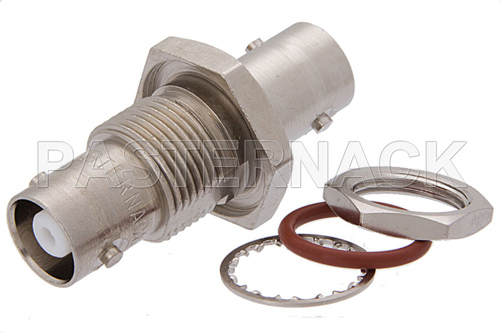
RF coaxial connectors are one of the most useful and ubiquitous methods of connecting RF systems and components. RF coaxial connectors are coaxial transmission lines made up of an RF coaxial cable and RF coaxial connectors terminating either end of the cable. RF connectors provide interconnect with other RF connectors, which must be of the same type, or at least a compatible time in some certain configurations.
The type of a coaxial connector is based on standardized geometries and specifications that define the physical aspect of a connector. The critical physical features are the internal geometries and dimensions of the coaxial connector. Mainly, how the center pin, dielectric, and outer conductor are structured and how the mating of two connectors ensure coaxiality and electrical connection that maintains the transverse electromagnetic (TEM) transmission mode.
RF Connector Type Specifications
• Connector type
• Gender
• Connector body
• Polarity
• Impedance
• Mounting method
• Attachment method
• Insulation material
• Body/outer conductor material/plating
• Contact/inner conductor material/plating
• Physical dimensions
Based on the materials, quality of construction, and internal geometries, a given coaxial connector will be designed for and specified for several core performance parameters. Maximum frequency and impedance are a function of the actual geometry ratios of inner conductor, dielectric constant of the dielectric material, and outer conductor. In most cases, it would be ideal that the coaxial connector behave as a perfect extension of the transmission line without any loss and with perfect match. As this isn’t possible with real materials and manufacturing methods, a given RF connector will have non-ideal VSWR, insertion loss, and return loss.
RF Connector Performance Specifications
• Maximum frequency
• Impedance
• VSWR
• Insertion loss
• Return loss
• Maximum Voltage
• Maximum Power handling
• PIM Response
Given the diversity of applications RF connectors are used, there are a variety of different standards, design features, construction methods, materials, and postprocessing steps that are used to make an RF connector better suited for a specific application. For instance, Hi-Rel RF connectors are typically designed to meet several military standards, or military specifications (MIL-SPEC), that specify a certain minimum for ruggedness and electrical performance. This is similar for other critical applications, such as space, aerospace, medical, industrial, automotive, and telecommunications which all have rigorous standards for every critical electrical component.
Common RF Connector Applications
• Hi-Rel (military, defense, government, and aerospace)
• RF Test & Measurement (T&M)
• Satellite Communications
• 4G/5G Cellular Communications
• Broadcast
• Wi-Fi/IoT Wireless Communications
• Medical
• Transportation
• Data Centers
• Building Automation
• Energy
Other Pasternack blog posts on RF coaxial connectors and accessories:
Introduction to RF/Microwave Launch Accessories & Field Replaceable Connectors
Basics of Coaxial Connector Attachment
How are End-launch, PCB Connectors Useful?
Benefits and Applications of Vertical Launch Solderless Connectors
Introduction to MIL-PRF-39012 and MIL-STD-348 Coaxial Connectors
Round-up of RF Quick Connect/Quick Disconnect Connectors
Overview of Military Standards for RF Cables and Connectors
Upper Microwave and Millimeter-wave Frequency Coaxial Connector Overview
BMA Connectors Push beyond Twist Tighten RF Connectors
What is so Special About the 4.3-10 Coaxial Connector?
How to Accessorize Your Coaxial Cable and Connector
What you need to know about Reverse Polarized Connectors




 Pasternack Blog
Pasternack Blog
